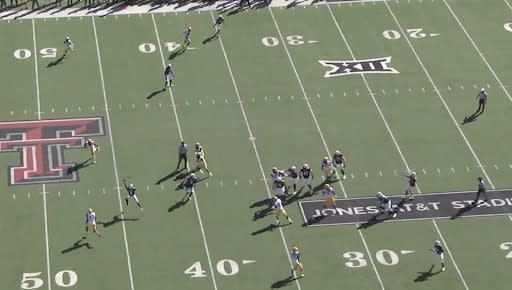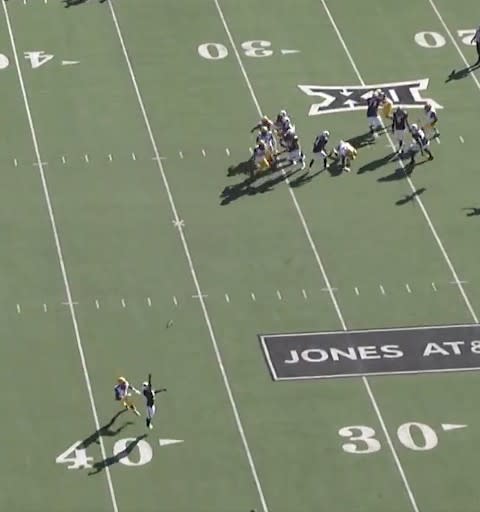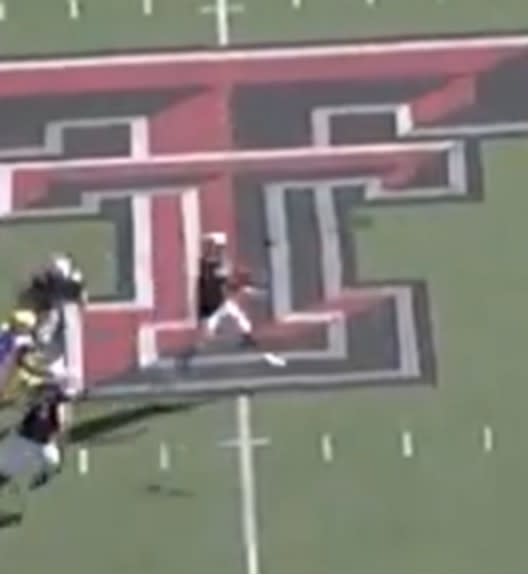Coming for the Kingdom: Patrick Mahomes' college tape hinted at the greatness that followed
The Kansas City Chiefs are trying to do something no team has ever done: win three straight Super Bowls.
The rest of the NFL is trying to stop them.
Here are the key elements of the Chiefs' success, which will again play a role in their quest — and could provide clues to how other teams can unseat the kings of the NFL.

Other stories in series:Rookies who could lift KC | Steve Spagnuolo's genius | How past 3-peat bids failed | What if Travis Kelce hits wall? | What can Chiefs teach rest of NFL? | 5 biggest threats to this dynasty
When I got my hands on a couple of games of 2016 Texas Tech All-22 video, I wanted to rewatch film through the lens of 2024 to see if there was anything we could learn from Patrick Mahomes: The Prospect.
Was the (probable) greatest player of all time hiding in plain sight on a .500 college team in Lubbock, led by a head coach in Kliff Kingsbury (hey, whatever happened to him?) whose own career arc was starting to trend downward?
There are statistics popular now that help us paint the picture of quarterback prospects. Measures like pressure-to-sack and time to throw help piece together a prospect’s profile. What kind of damage a quarterback was able to mitigate, how far are they pushing the ball, where are they pushing the ball (with needed context of actually watching the players, of course)? Mahomes was painted as a wild horse of a player who needed to be reined in to have any chance of becoming playable in the NFL, but there were measures that pointed to a more nuanced player than even what first meets the eye when you watched him in Lubbock.
What were my impressions of actually watching Mahomes in college? Well, in the first game I watched, Mahomes completely sailed his first two throws of the game and the Red Raiders went three-and-out.


So, no. The skies did not part right away during this exercise and I am not here to reveal that it was oh-so-obvious and there was a simple trick to find the next Hall of Fame quarterback.
Mahomes’ footwork was pretty wonky. Much was made about it at the time, and it still remains “a thing” with prospect discourse (less QB footwork guys and more tackle kicksteps, please) but it’s an important example of just how many variables go into player evaluation. Mahomes had more than a handful of misses on his film, especially in the game against West Virginia.
It wasn't all perfect, though. There were plenty of random misses and ill-advised extended plays that would crop up when watching Mahomes. pic.twitter.com/wWvdyvJNBd
— Nate Tice (@Nate_Tice) September 4, 2024
The misses came in a variety of ways. Mostly when he was moving off of his launch point, which is a common reason for inaccuracy in young quarterbacks.
It wasn’t as if Mahomes couldn’t hit the broad side of a barn, which is what's so, so important about this. Inconsistent isn’t damning and might not even be bad. It’s just inconsistent. For instance, Mahomes was a machine when throwing underneath routes, like on screens, hitches and bubbles (I’ll spare you with the dozen clips I saved of 5-yard gains on wide receiver screens that are a large part of a typical Air Raid offense). That underneath accuracy is something Mahomes has long been underrated on, even as a professional. His whip-like motion gets the ball promptly on his teammates, enabling them to get their eyes forward and ready to make plays. His footwork may have been all over the place when he made those throws, but he was still putting the ball on the money to his receivers.
And when Mahomes felt clean, he could put the football wherever he wanted. He not only has a strong arm but it’s a functional strong arm that could attack the sidelines or 60-plus yards downfield.
ok one more pic.twitter.com/zOezEb8kcv
— Nate Tice (@Nate_Tice) September 4, 2024
You may have noticed Mahomes leaning back on that throw. And that was something he had a tendency to do in college, which led to some misses here and there but was also a ramification of how much pressure Mahomes was constantly under in college. Texas Tech’s protection scheme was often outmatched (there were times when Mahomes would spend a good 10 seconds during the pre-snap process getting everyone aligned only for the player lined up right over the center to remain unblocked after the ball was snapped).
His feet were wonky and inconsistent, but it was more because he was constantly moving and working to find angles to throw from. It wasn't so much jitteriness, elongated steps or lack of rhythm like with other quarterbacks labeled with shoddy footwork (think Kenny Pickett or Zach Wilson). Mahomes doesn’t play like he’s on too much caffeine, but more like a wacky waving inflatable tube guy. Or a drunken boxer, constantly bending and waving his body as carnage happens around him and holes to make plays open up. He could launch a throw the width of a football field but also set his feet and eephus pitch a back shoulder for a completion.
alright so I watched a couple of games of Patrick Mahomes in college for an article that's coming out later today and I just had to share this pic.twitter.com/ZTPJsHFU8l
— Nate Tice (@Nate_Tice) September 4, 2024
the touch Mahomes he also showed at times was exquisite pic.twitter.com/UOXmEJoihP
— Nate Tice (@Nate_Tice) September 4, 2024
The footwork was inconsistent, but it shouldn’t have been a conversation ender for Mahomes as a prospect. He constantly made plays without that footwork being pristine. Sure, there were misses, but there was so much good, even when it was somewhat calm or even when it was splayed about. And footwork is something that, if the player is highly athletic, is fixable with time and coaching. These are the “mechanics” that are actually workable (as opposed to a straight throwing motion).
It’s hindsight 20/20 analysis to say this now, but Mahomes being able to complete passes from so many angles, especially with the passing variety that happens in today’s NFL, should have been more of a positive argument than it is now. Again, the footwork should be able to be cleaned up (otherwise why are these guys paying their private coaches?). It’s a case-by-case basis, but when watching Mahomes in college, the lack of every-down consistency could have easily been chalked up to youth (he was a true junior who was also a college baseball player who likely didn’t have much true spring time to focus on football) and the offense being more “loose” in its discipline for timing.
The upside of his athleticism, flexibility and arm talent allowed him do stuff like this:
Passing downs is when Patrick Mahomes' Texas Tech film really comes alive.
Pushing the ball past the sticks, extending plays, timely scrambles. He handled a ton presnap and there are tons of signs of a QB that "got" it.
Plus he could do some demonic things with the football. https://t.co/HPo6u9y10Mpic.twitter.com/Iuoooqhy3z— Nate Tice (@Nate_Tice) September 4, 2024
You absolutely first and foremost want to see a quarterback operate within the offense's structure. We chase the flashes of big plays with quarterbacks, but if they aren’t able to consistently move the chains, it’s a very hard way to live in the NFL unless you have a bona fide run game to offset a high variance passing game (hello, 2024 Titans?).
Mahomes showed that he could pepper throws underneath with accuracy and pace. But I could see how it was hard to say he’s “consistently accurate” or “polished” when Mahomes finished a pass looking like he’s skipping over the midfield stripe.

Sometimes, though, it’s best to see how quarterbacks throw on the move or when they're outside the rhythm of the offense (South Florida's Byrum Brown is a great example of a current prospect for this). This can be a better glimpse to their actual athleticism and ability to remain accurate outside of glorified practice drills or sparkly clean pockets. That's especially useful when translating to the muddier world of NFL pockets.
Mahomes, as a professional, is currently the best of both worlds. But it wasn’t all perfect within the structure as far as his final result in college, whether it was because of his footwork, a pressured throw or a shoddy job by his pass catcher. But there were signs of his process being extremely advanced. Whether you want to characterize it as “feel,” “football IQ,” “ball knowledge” or being a “film rat,” Mahomes showed off the little things that add up to bigger results.
He handled protections and play changes on nearly every snap. He had a constant awareness for where the sticks were and had an allergy for throwing underneath them. His feel for scrambling lanes was apparent even in college, where he was a hyper-efficient runner just like he has been as a professional. This was a quarterback who was given the keys to the offense as a true junior and he was handling it.
Mahomes showed a great feel for when to turn the dials between pushing for a big throw, looking to extend the play and when to mitigate damage and throw it away. He would get caught a few times in the games I reviewed for a sack late in the down, but there were many times he was able to work away from a free pass rusher or get throws off at the last second by eking out space and time. It also wasn’t like Texas Tech had much else it could rely on to create any of these plays and it has to be emphasized that he wasn’t often putting the football in danger. Mahomes would either run or stand in there to create another first down out of nothing.
... https://t.co/ja4U5CV9aYpic.twitter.com/0If7e4GckH
— Nate Tice (@Nate_Tice) September 4, 2024
Even on some of his whirlybird plays, where Mahomes would seemingly touch every corner of the field before throwing, Mahomes was trying them at proper times, like on third-and-long or when the defense was flooding the passing lanes with bodies (or more likely no one was getting open). Again, like the drunken boxer, it may seem like random movements, but Mahomes’ feel for manipulating the pocket and extending plays was apparent even in this small glimpse of film review.
It was chaotic, but it was calculated chaos. Something that Mahomes has carried over as a Kansas City Chief.
Prospect evaluation is hard. Mahomes was the 10th pick in the 2017 NFL Draft and even that seemed like a stretch to some talent evaluators at the time. So, what did we learn?
Well, traits matter, of course. But, make-up matters so much with these players. Mahomes showed much more maturity in terms of handling the offense and with his eyes to find the right throw than you would have assumed for a player who sat his first season in the NFL. His footwork needed to be cleaned up, but this was a player who was an obvious football junkie. Even if the offense was “simpler” in college, it’s still noteworthy that Kingsbury and the Texas Tech staff gave Mahomes so much leeway in operating it. His toughness and willingness to find any way to find the next big play also stood out.
Would Mahomes have become the player he is now if he wasn’t able to sit that first year or if he didn’t end up with Andy Reid and the Chiefs' offense? It’s tough to say. There were glimpses of something special when watching some of his highlights and all the in-between stuff he did in the operation. But not every diamond gets cleaned up to shine as brightly as Mahomes does today. There won’t be a “next Mahomes” (although Nebraska QB Dylan Raiola is doing his best impression) but there are things to glean from this, even if it’s fun to just watch a young Patrick Mahomes go nuts for a little bit.
the mannerisms are hilariously similar https://t.co/TZbb61aDnCpic.twitter.com/eiKPO7kdNj
— Nate Tice (@Nate_Tice) September 3, 2024


